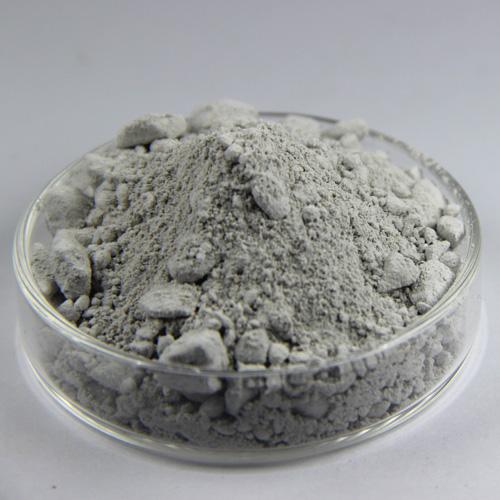
The unshaped refractory material used when repairing the lining of thermal equipment by spray construction method is called refractory gunning material. It is made of a refractory set with a certain particle gradation
Refractory gunning material for inner lining maintenance of blast furnace
The unshaped refractory material used when repairing the lining of thermal equipment by spray construction method is called refractory gunning material. It is composed of refractory aggregates with certain particle gradation, chemical binders and additives, and is generally a thermosetting or gas-hardening material. The selection of the main material is based on the maximum temperature fluctuation range that may be reached in the kiln, the properties of the slag, and the material of the lining itself.
The particle size composition and limit particle size of the gunning material and the spraying layer should be determined according to the structure of the gunning machine, the thickness of the gunning layer and different gunning methods. Improper selection of particle size or unreasonable particle gradation have a great influence on the adhesion of gunning material and the density of the gunning layer. Under normal circumstances, the wet and dry spraying particles are too coarse and too many particles will lead to a decrease in the adhesion rate. Generally, the multi-critical particle size of the dry gunning material is larger than that of the wet spray gunning material, and sometimes it can reach 6~7mm or even larger. Fire spray gunning material is divided into wet method (mud method) gunning material, semi-dry method (nozzle mixing type) gunning material and flame method (melting method) gunning material according to the construction method: according to the main material of the gunning material Divided into magnesia, magnesia-calcium, magnesia-chromium, magnesia-carbon, aluminum silicate and alumina-silicon-oxide-carbon gunning materials, etc.: according to the conditions of use, it is divided into gunning materials for converters and gunning for electric furnaces material, gunning material for ladle, gunning material for vacuum degassing furnace (RH, DH), gunning material for tapping ditch and gunning material for blast furnace lining, etc.
|
Project |
index |
|||
|
GWP-35 |
GWP-45 |
GWP-55 |
||
|
Al2O3≥ |
35 |
45 |
55 |
|
|
Fe2O3≤ |
1.5 |
1.5 |
1.0 |
|
|
Refractoriness/CN≥ |
152 |
164 |
168 |
|
|
Bulk density (g/cm3)(110℃×3h)≥ |
2.00 |
2.10 |
2.20 |
|
|
Normal temperature compressive strength |
110℃×24h after dry |
30 |
35 |
35 |
|
1000℃×3h after burning |
25 |
30 |
30 |
|
|
heat treatment temperature×3h |
45(1200℃) |
50(1400℃) |
55(1500℃) |
|
|
Permanent line rate of change |
1000℃×3h after burning |
±0.5 |
±0.5 |
±0.5 |
|
Experimental temperature×3h |
±1.0(1200℃) |
±1.0(1400℃) |
±1.0(1500℃) |
|
Refractory gunning material characteristics are :
simple operation
high adhesion rate
rapid sintering, no dust
low rebound rate
mechanized or automated construction
shortening the construction period
saving labor
and reducing costs
Acid resistant refractory gunning material is used for spraying of blast furnaces, hot blast stoves, hot blast pipes, flue protection layers, working layers, etc.
Converter, electric furnace gunning material has the characteristics of high adhesion rate, good high temperature corrosion resistance, etc.
High alumina brick is one of the indispensable basic refractory materials in the upper and middle parts of blast furnace body in iron and steel industry
In the blast furnace smelting process, blast furnace taphole clay, as a key plastic material, plays a vital role. This article will introduce in detail the product characteristics, working principle and innovation of blast furnace taphole clay in improving furnace stability and production efficiency.
Chrome corundum brick refers to corundum refractory products containing Cr2O3. At high temperature, Cr2O3 and Al2O3 form a continuous solid solution, so the high temperature performance of chromium corundum products is better than that of pure corundum products. Chromium corundum products are widely used, and the content of Cr2O3 is mostly in the range of 9% to 15%.
Silica bricks for coke ovens are siliceous refractory products used for building coke ovens with tridymite as the main crystal phase. Coke oven silica bricks are used to build regenerator walls, ramps, combustion chambers, carbonization chambers and furnace roofs of coke ovens. Silica brick is an acid refractory material with good resistance to acid slag erosion. The softening temperature under load is as high as 1640-1670 °C, and the volume is relatively stable in long-term use at high temperature.
The high-alumina refractory bricks sold by Yuying refractory manufacturers are commonly used refractory bricks with high thermal stability and refractoriness above 1770°C. It has good slag resistance and is used for the lining of steelmaking electric furnaces, glass melting furnaces, cement rotary furnaces, etc.
Anhydrous tap hole mix for blast furnace tap hole



